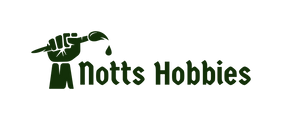Miniature Painting Glossary
Miniature painting is full of unique techniques, tools, and terms that can be confusing to newcomers.
This glossary is designed to help painters of all levels quickly understand the language of the hobby, from basic tools to advanced effects, so you can focus on bringing your miniatures to life with confidence and creativity.
Acrylic Paint – Is a fast drying water based paint used in miniature painting, made by brands including Citadel, Vallejo and Army Painter
Basecoat – Applying a flat layer of colour over all of a surface
Blending – creating a smooth change from one colour to another colour
Cold Colours - hues like blue, green, and purple that evoke coolness and calm
Contrast - Highlights differences in colour, value, texture and shape to create visual interest and guide the viewer’s attention
Contrast Paints/Speed Paints – Paint that is half way between normal acrylic paint and a wash, applied in one coat and more pigment settles in the recesses.
Desaturated – a colour that is muted or greyish because other colours have been mixed into it.
Drybrush – Is a wide paint brush that doesn’t have a tip, designed for drybrushing
Drybrushing - a miniature painting technique where most of the paint is removed from the brush so it deposits paint on the raised surfaces of a model.
Focal Point – is the area designed to draw the viewer’s attention first
Glazing - painting a very thin layer of paint to tint a surface
Highlight – painting the bright colours on raised parts of a model so they stand out.
Highly Saturated – a bright colour that doesn’t have other colours mixed into it.
Midtone – the mid point of a surface that isn’t highlights or shadows
Overbrushing - a miniature painting technique where some of the paint is removed from the brush so the paint isn’t deposited in the deepest parts of a model.
Primer – prepares the surface of the model for paint, applied from a spray can or an airbrush.
Shadows – The deepest parts of a surface, that receive the least light.
Sponge Chipping - a paint-dabbed sponge is lightly applied to edges and surfaces to create realistic chipped or worn effects
Stippling - applying paint in small, controlled dots
Touch Up – painting over a colour from a different part of a model
Texture Palette - is a non-absorbent surface where painters water down paints and remove excess paint from their brush.
Warm Colours - hues like red, orange, and yellow that evoke warmth and energy
Wash – A thinned-down paint that runs into the recesses
Wet Blending – creating a smooth change from one colour to another colour before the paint dries
Wet Palette - a painting tool with a damp sponge and permeable paper that keeps acrylic paints moist and workable for longer.
Zenithal Painting – A style of painting that uses the sun as the main light source.


Leave a comment